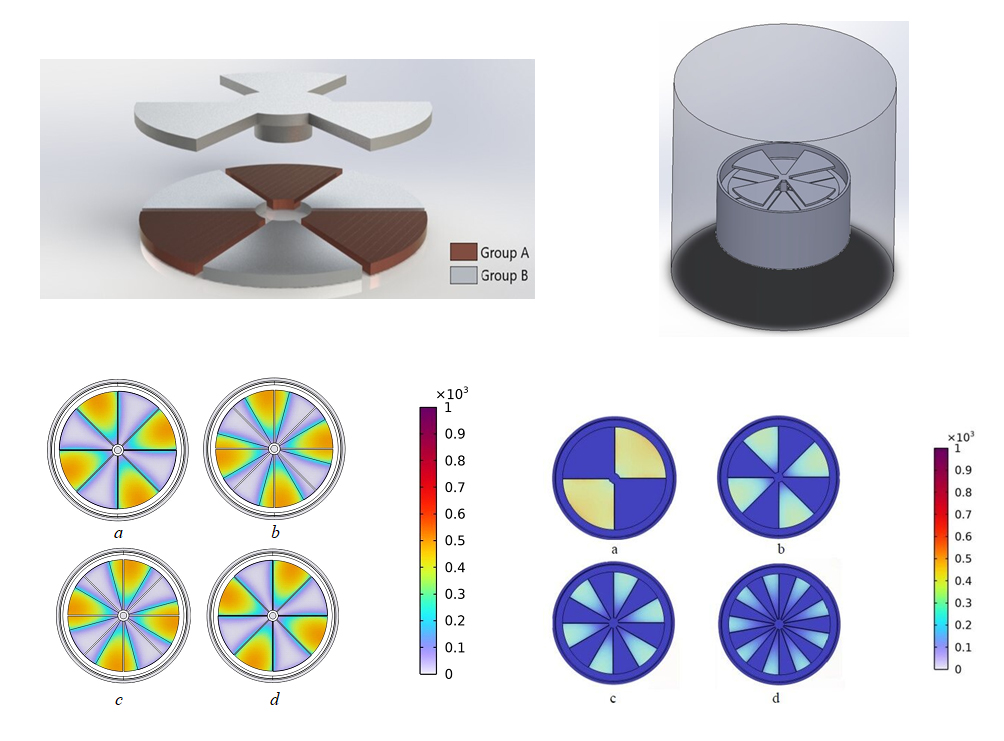Increasing sensitivity of the electrostatic field mill sensor by determining its optimal configuration
DOI:
https://doi.org/10.15587/2706-5448.2023.292919Keywords:
electrostatic fields, electrostatic discharge, electrostatic field mill, measurement, sensor sensitivityAbstract
The object of research is the process of measuring the strength of the electrostatic field for a low dynamic range (from 0 to 1 kV/m). This study is aimed at increasing the sensitivity of the sensor of the electrostatic field mill (EF) by determining its optimal geometric configuration, which will reduce the error of measuring the electrostatic field strength.
To establish the actual value of the induced current, a computer model was built and simulation modeling of the EF sensor was carried out. On the basis of the constructed computer model, studies of the EF sensor were carried out to determine the numerical value of the induced current. As a result, it was established that the occurrence of edge effects leads to the appearance of methodological error, which occurs due to the fact that the average induced current is smaller compared to the calculated value. As a result of computer modeling of the EF sensor to determine the value of the optimal number of sectors, it was established that for the proposed design of the EF sensor, the optimal number of sectors is six. It was established that the optimal value of the distance between the sensitive plates and the shielded rotor should be in the range of 2.5–3 mm to ensure the maximum sensitivity of the EF sensor and its safe use.
The determined optimal parameters of the EF geometric configuration will allow to form the necessary requirements for the construction of improved electrostatic field strength meters in a low dynamic range (from 0 to 1 kV/m). A promising direction of application of such devices in production will be the development of an additional system for monitoring the strength of the electrostatic field, which will allow to prevent the occurrence of a dangerous situation.
References
- ESDA/JEDEC Joint Standard For Electrostatic Discharge Sensitivity Testing – Charged Device Model (CDM) – Device Level, JS-002-2022. ANSI/ESDA/JEDEC (2022). Rome, New York.
- ESDA/JEDEC Joint Standard For Electrostatic Discharge Sensitivity Testing – Human Body Model (HBM) – Component Level, JS-001-2023. ANSI/ESDA/JEDEC (2023). Rome, New York.
- Voldman, S. H. (2021). ESD Handbook. John Wiley & Sons, Ltd. doi: https://doi.org/10.1002/9781119233091
- Smallwood, J. (2023). A Guide to ESD. EMC Information Centre. Available at: https://www.nutwooduk.co.uk/archive/old_archive/030923.htm Last accessed: 19.11.2023
- Fundamentals of Electrostatic Discharge. Part One – An Introduction to ESD (2020). EOS/ESD Association, Inc. Available at: https://www.esda.org/esd-overview/esd-fundamentals/part-1-an-introduction-to-esd/ Last accessed: 19.11.2023
- Pan, S., Zhang, Z. (2018). Fundamental theories and basic principles of triboelectric effect: A review. Friction, 7 (1), 2–17. doi: https://doi.org/10.1007/s40544-018-0217-7
- Ruffat, F., Caignet, F., Boyer, A., Escudié, F., Mejecaze, G., Puybaret, F. (2022). New measurement method to investigated service life of protection networks exposed to ESD. Microelectronics Reliability, 138, 114661. doi: https://doi.org/10.1016/j.microrel.2022.114661
- Gao, Y., Cai, X., Han, Z., Zeng, C., Xia, R., Tang, Y., Gao, M., Li, B. (2023). Design of compact-diode-SCR with low-trigger voltage for full-chip ESD protection. Microelectronics Reliability, 140, 114860. doi: https://doi.org/10.1016/j.microrel.2022.114860
- Protection Of Electrical And Electronic Parts, Assemblies And Equipment (Excluding Electrically Initiated Explosive Devices), S20.20-2021, ANSI/ESD (2021). Rome, New York.
- Electrostatics – Part 5-2: Protection of Electronic Devices from Electrostatic Phenomena – User Guide, TR 61340-5-2:2018 (2018). IEC.
- ESD Association Advisory for Electrostatic Discharge Terminology – Glossary, ADV1.0-2017 (2017). ESD.
- Righter, A., Carn, B. (2017). A Look at the New ANSI/ESDA/JEDEC JS-002 CDM Test Standard. Analog Dialogue, 51 (4), 11–15. Available at: https://www.analog.com/en/analog-dialogue/articles/a-look-at-the-new-ansi-esda-jedec-js-002-cdm-test-standard.html
- Ponnle, A. A. (2022). Measurement and Assessment of Exposure to 50 Hz Magnetic Fields from Common Home Electrical Appliances. European Journal of Engineering and Technology Research, 7 (3), 119–127. doi: https://doi.org/10.24018/ejeng.2022.7.3.2832
- Xiao, D., Ma, Q., Xie, Y., Zheng, Q., Zhang, Z. (2018). A Power-Frequency Electric Field Sensor for Portable Measurement. Sensors, 18 (4), 1053. doi: https://doi.org/10.3390/s18041053
- Oltean, M. N., Fagarasan, T., Florea, G., Munteanu, C., Pop, A. (2017). Electromagnetic field measurement on high voltage overhead lines. 2017 12th International Conference on Live Maintenance (ICOLIM). doi: https://doi.org/10.1109/icolim.2017.7964148
- Povcshenko, O., Bazhenov, V. (2023). Analysis of modern atmospheric electrostatic field measuring instruments and methods. Technology Audit and Production Reserves, 4 (1 (72)), 16–24. doi: https://doi.org/10.15587/2706-5448.2023.285963
- Swenson, J. A., Beasley, W. H., Byerley, L. G., Bogoev, I. G. (2017). Pat. US 7.256,572 USA. Electric-field meter having current compensation. published: 14.08.2007. Available at: https://patents.google.com/patent/US7256572B2/en?oq=US+7.256%2c572
- Chester, D. S. (1976). Pat. US 4'095'221 USA. Electrical storm forecast system. published: 13.07.1976. Available at: https://patents.google.com/patent/US4095221A/en?oq=US+4%27095%27221
- Wells, T. J., Elliott, R. S. (2005). Pat. US 6'982'549 USA. Micro-electrometer. published: 05.12.2005. Available at: https://patents.google.com/patent/US6982549B1/en?oq=US+6%27982%27549
- Bazhenov, V., Povcshenko, O. (2023). Methodological features of calculating errors in the measurement of electrostatic field strength. Bulletin of Kyiv Polytechnic Institute. Series Instrument Making, 65 (1), 65–72. doi: https://doi.org/10.20535/1970.65(1).2023.283358
- Antunes de Sá, A., Marshall, R., Sousa, A., Viets, A., Deierling, W. (2020). An Array of Low‐Cost, High‐Speed, Autonomous Electric Field Mills for Thunderstorm Research. Earth and Space Science, 7 (11). doi: https://doi.org/10.1029/2020ea001309

Downloads
Published
How to Cite
Issue
Section
License
Copyright (c) 2023 Oleksandr Povcshenko, Olha Pazdrii

This work is licensed under a Creative Commons Attribution 4.0 International License.
The consolidation and conditions for the transfer of copyright (identification of authorship) is carried out in the License Agreement. In particular, the authors reserve the right to the authorship of their manuscript and transfer the first publication of this work to the journal under the terms of the Creative Commons CC BY license. At the same time, they have the right to conclude on their own additional agreements concerning the non-exclusive distribution of the work in the form in which it was published by this journal, but provided that the link to the first publication of the article in this journal is preserved.







